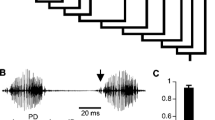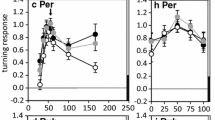Summary
Acoustic orientation of receptive female crickets (Gryllus campestris L.) towards the calling song (Fig. 2) of a conspecific male is investigated using a locomotion compensator (Fig. 1). By applying this method we restrict neither the path-length nor the walking direction of the walking cricket. At the same time the method provides a continuous record of the walking parameters (path of the cricket, velocity, walking direction, and angular velocity).
The locomotion compensator ensures that the distance between cricket and loudspeaker and thus the calling song intensity remain constant; nevertheless the phonotactic response is not seriously affected during the experiments (Fig. 6).
Compared to walking without calling song presentation (Fig. 3), acoustically orientated walking shows the following characteristic features:
-
(i)
persistent course towards the sound source (Figs. 6–8);
-
(ii)
oscillations of 30–60 ° amplitude around the direction of the sound source (Figs. 8, 10);
-
(iii)
a nearly sinusoidal angular characteristic of corrective turns (Fig. 9);
-
(iv)
increased mean velocity (Fig. 4);
-
(v)
short stops (about 0.6 s) with small variance in duration between continuous walking periods of variable duration (Fig. 10, Table 1).
Gryllus campestris females utilize information about sound direction both during stops and during walking (Fig. 10). However, the time needed for correction of a given course deviation during walking exceeds that during stops (Fig. 12).
With increasing calling song intensity the crickets pursue their course direction more precisely and the correspondence between mean walking direction and sound direction improves (Figs. 13–15).
The female crickets investigated exploit bilateral differences in reaction amplitude of auditory neurons and not those in reaction time for detection of sound direction (see Discussion).
Similar content being viewed by others
References
Autrum H (1941) Über Lautäußerungen und Schallwahrnehmung bei Arthropoden II. Das Richtungshören vonLocusta und Versuch einer Hörtheorie für Tympanalorgane vom Locustidentyp. Z Vergl Physiol 28:326–352
Autrum H (1963) Anatomy and physiology of sound receptors in invertebrates. In: Busnel RG (ed) Acoustic behaviour of animals. Elsevier, New York, pp 412–433
Bailey WJ, Thomson P (1977) Acoustic orientation in the cricketTeleogryllus oceanicus (Le Guillou). J Exp Biol 67:61–75
Cade WH (1979) Effect of male-deprivation on female phono-taxis in field crickets (Orthoptera: Gryllidae;Gryllus). Can Entomol 111:741–744
Hill KG (1974) Acoustic communication in the Australian field cricketsTeleogryllus commodus andT. oceanics (Orthoptera: Gryllidae). Doctoral thesis, University of Melbourne
Hill KG, Boyan GS (1977) Sensitivity to frequency and direction of sound in the auditory system of crickets (Gryllidae). J Comp Physiol 121:79–97
Huber F (1960) Experimentelle Untersuchungen zur nervösen Atmungsregulation der Orthopteren (Saltatoria: Gryllidae). Z Vergl Physiol 43:359–391
Klopffleisch KD (1973) Ethologische Untersuchungen an der FeldgrilleGryllus campestris L. an natürlichen Standorten. Staatsarbeit, Universitöt Köln
Kramer E (1975) Orientation of the male silkmoth to the sex attractant bombycol. In: Denton DA, Coghlan JP (eds) Olfaction and taste V. Academic Press, New York, pp 329–335
Kramer E (1976) The orientation of walking honeybees in odour fields with small concentration gradients. Physiol Entomol 1:27–37
Larsen ON, Michelsen A (1978) Biophysics of the ensiferan ear. III. The cricket ear as a four-input system. J Comp Physiol 123:217–227
Mörchen A (1980) Spike count and response latency. Two basic parameters encoding sound direction in the CNS of insects. Naturwissenschaften 67:469–470
Mörchen A, Rheinlaender J, Schwartzkopff J (1978) Latency shift in insect auditory nerve fibers. A neuronal time cue of sound direction. Naturwissenschaften 65:656–657
Murphey RK, Zaretsky MD (1972) Orientation to calling song by female crickets,Scapsipedus marginatus (Gryllidae). J Exp Biol 56:335–352
Oldfield BP (1980) Accuracy of orientation in female crickets,Teleogryllus oceanicus (Gryllidae): Dependence on song spectrum. J Comp Physiol 141:93–99
Paton JA, Capranica RR, Dragsten PR, Webb WW (1977) Physical basis for auditory frequency analysis in field crickets (Gryllidae). J Comp Physiol 119:221–240
Pollack GS, Plourde N (1982) Directionality of acoustic orientation in flying crickets. J Comp Physiol 146:207–215
Popov AV, Shuvalov VF (1974a) Time-characteristics of communicative sounds and their analysis in the auditory system of insects. Acustica 31:315–319
Popov AV, Shuvalov VF (1974b) The spectrum, intensity, and direction of the calling song of the cricketGryllus campestris under natural conditions. J Evol Biochem Physiol 10:72–80 (in Russian)
Popov AV, Shuvalov VF (1977) Phonotactic behaviour in crickets. J Comp Physiol 119:111–126
Popov AV, Shuvalov VF, Svetlogorskaya ID, Markovich AM (1974) Acoustic behaviour and auditory system in insects. In: Schwartzkopff J (ed) Mechanoreception. Rhein-Westf Akad Wiss Abh 53:281–306
Regen J (1912) Experimentelle Untersuchungen über das Gehör vonLiogryllus campestris L. Zool Anz 40:305–316
Regen J (1913) Über die Anlockung des Weibchens vonGryllus campestris L. durch telephonisch übertragene Stridulationslaute des Mönnchens. Pflügers Arch 155:193–200
Regen J (1923) Über die Orientierung des Weibchens vonLiogryllus campestris L. nach dem Stridulationsschall des Mönnchens. Sitzungsber Akad Wiss (Wien) 132:81–88
Regen J (1928) Besitzen die Insekten einen Gehörsinn? Forsch Fortschr 4:47–48
Rheinlaender J, Blätgen G (1982) The precision of auditory lateralization in the cricketGryllus bimaculatus. Physiol Entomol 7:209–218
Rheinlaender J, Römer H (1980) Bilateral coding of sound direction in the CNS of the bushcricketTettigonia viridissima L. (Orthoptera, Tettigoniidae). J Comp Physiol 140:101–111
Schmitz B (1979) Untersuchungen zur Phonotaxis bei der Feldgrille (Gryllus campestris L.). Diplomarbeit, Universitöt Köln
Schmitz B, Scharstein H (1981) Mechanismus der akustischen Orientierung bei Grillen-Weibchen (Gryllus campestris L.). Verh Dtsch Zool Ges 1981:267
Shuvalov VF, Popov AV (1972) Reaction of females of the domestic cricketAcheta domestica to sound signals and its changes in ontogenesis. J Evol Biochem Physiol 7:612–615 (in Russian)
Shuvalov VF, Popov AV (1973) The importance of the calling song rhythmic pattern of males of the genusGryllus for phonotaxis of females. Zool J (Moskow) 52:1179–1185 (in Russian)
Stout JF, Gerard G, Hasso S (1976) Sexual responsiveness mediated by the corpora allata and its relationship to phonotaxis in the female cricket,Acheta domesticus L. J Comp Physiol 108:1–9
Thorson J, Weber, T, Huber F (1982) Auditory behaviour of the cricket. II. Simplicity of calling-song recognition inGryllus, and anomalous phonotaxis at abnormal carrier frequencies. J Comp Physiol 146:361–378
Weber T, Thorson J, Huber F (1981) Auditory behaviour of the cricket. I. Dynamics of compensated walking and discrimination paradigms on the Kramer treadmill. J Comp Physiol 141:215–232
Wendler G (1975) Physiology and systems analysis of gravity orientation in two insect species (Carausius morosus, Calandra granaria). Fortschr Zool 23:33–48
Wendler G, Dambach M, Schmitz B, Scharstein H (1980) Analysis of the acoustic orientation behaviour in crickets (Gryllus campestris L.). Naturwissenschaften 67:99–100
Zhantiev RD, Kalinkina IN, Chukanov VS (1975) Characteristics of the directional sensitivity of the tympanal organs in the cricketGryllus bimaculatus Deg. (Orthoptera, Gryllidae). Entomol Obozr 54:249–257
Author information
Authors and Affiliations
Rights and permissions
About this article
Cite this article
Schmitz, B., Scharstein, H. & Wendler, G. Phonotaxis inGryllus campestris L. (Orthoptera, Gryllidae). J. Comp. Physiol. 148, 431–444 (1982). https://doi.org/10.1007/BF00619782
Accepted:
Issue Date:
DOI: https://doi.org/10.1007/BF00619782




